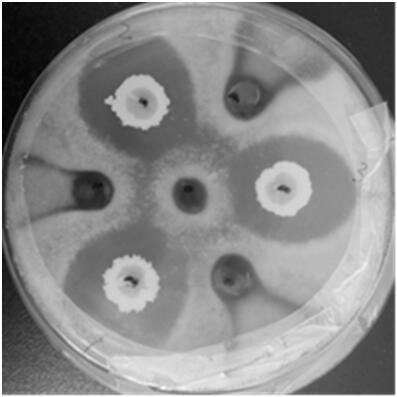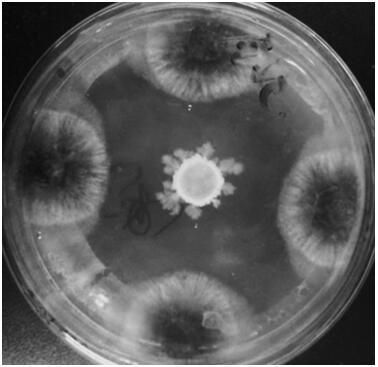Spore-producing bacillus amyloliquefaciens for inhibiting plant pathogenic fungi and application of spore-producing bacillus amyloliquefaciens
A technology for plant pathogenic fungi and amylolytic spores, which is applied in the fields of microbiology and biology to achieve the effects of high inhibition rate, high antibacterial spectrum, and broad antibacterial spectrum.
- Summary
- Abstract
- Description
- Claims
- Application Information
AI Technical Summary
Problems solved by technology
Method used
Image
Examples
Embodiment 1
[0047] Example 1 Evaluation of the production potential of Bacillus amyloliquefaciens 1841
[0048] After sterilizing 50 ml of NBY medium (pH 7.0) at 120°C and 0.8 atmospheres for 30 min, place it in a 750 ml sterile vial and cool to 20°C. After inoculating Bacillus amyloliquefaciens 1841 in the culture medium at 30°C and 250 rpm / min for 16 h, 5-10 ml of culture was obtained. Microscopy to ensure that there is no contamination, the concentration of the culture product is checked by the microscope, and the number of cells should reach 10 9 cfu / ml.
[0049] After the above-mentioned cultured Bacillus amyloliquefaciens 1841 and the control strain Bacillus amyloliquefaciens CGMCC No. 4777, which has the best antibacterial effect, were cultured on YM medium for 72 hours, the productivity (titer) of the two strains was observed. , The results are shown in Table 1.
[0050] Table 1 Comparison of productivity (titer) between the strain of the invention and the control strain
[0051]
[00...
Embodiment 2
[0053] Example 2 Evaluation of antifungal activity of Bacillus amyloliquefaciens 1841
[0054] The punching method was used to detect Bacillus amyloliquefaciens 1841 and the control strain Bacillus amyloliquefaciens CGMCC NO.4777, against Sclerotinia sclerotiorum, Alternaria tenuis, Fusarium oxysporum, Pyricularia oryzae, Gray leaf spot, Botrytis cinerea The bacteriostatic activity and the bacteriostatic range (mm) are shown in Table 2.
[0055] Table 2 Comparison of antibacterial activity of the present strain and the control strain
[0056]
[0057] Description: 1. Sclerotinia sclerotiorum, Alternaria tenuis, Fusarium oxysporum, Pyricularia oryzae, and Gray leaf spot are the inhibitory range of fungal growth when using a 1:500 diluted bacterial culture solution.
[0058] 2. Botrytis cinerea is the antibacterial growth range when using undiluted bacterial culture solution.
[0059] It can be seen from Table 2 that the ability of Bacillus amyloliquefaciens 1841 of the present invention...
Embodiment 3
[0060] Example 3 Evaluation of antifungal activity of Bacillus amyloliquefaciens 1841 culture solution in different dilutions
[0061] The punching method was used to detect different dilution concentrations of Bacillus amyloliquefaciens 1841 and the control strain Bacillus amyloliquefaciens CGMCC NO.4777 culture solution, co-inoculated with Sclerotinia sclerotiorum, Alternaria tenuis, Fusarium oxysporum, and corn ash The antifungal activity of plaque fungus and the growth of fungi (mm) are shown in Table 3.
[0062] Table 3 Comparison of antifungal activity of the present strain and the control strain under different dilution concentrations of culture solution co-inoculation
[0063]
[0064] It can be seen from Table 3 that the ability of Bacillus amyloliquefaciens 1841 of the present invention to inhibit the growth of Sclerotinia sclerotiorum, Alternaria tenuis, Fusarium oxysporum, and Pyricularia oryzae is better than the control bacterium CGMCC No. 4777, while inhibiting corn T...
PUM
| Property | Measurement | Unit |
|---|---|---|
| Diameter | aaaaa | aaaaa |
Abstract
Description
Claims
Application Information
 Login to View More
Login to View More - R&D
- Intellectual Property
- Life Sciences
- Materials
- Tech Scout
- Unparalleled Data Quality
- Higher Quality Content
- 60% Fewer Hallucinations
Browse by: Latest US Patents, China's latest patents, Technical Efficacy Thesaurus, Application Domain, Technology Topic, Popular Technical Reports.
© 2025 PatSnap. All rights reserved.Legal|Privacy policy|Modern Slavery Act Transparency Statement|Sitemap|About US| Contact US: help@patsnap.com



